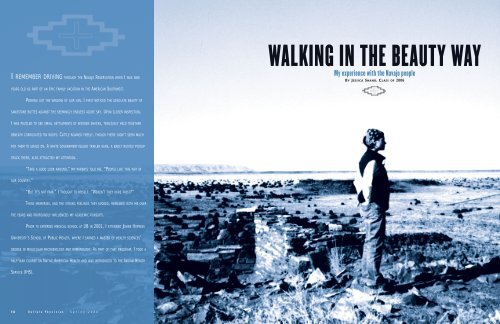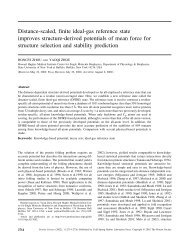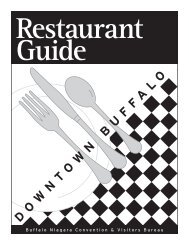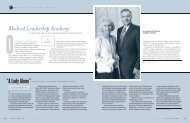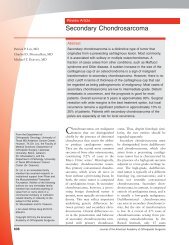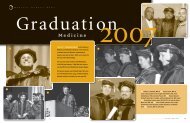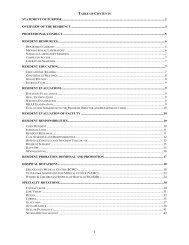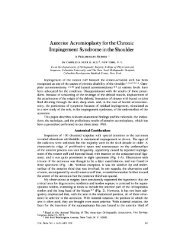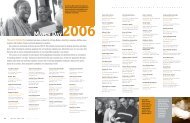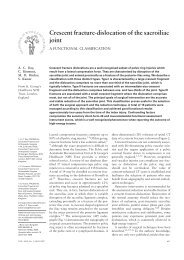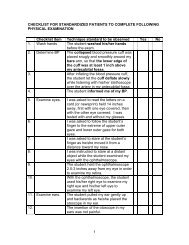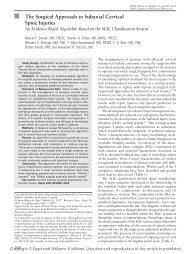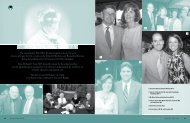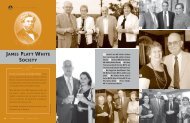WALKING IN THE BEAUTY WAY
WALKING IN THE BEAUTY WAY
WALKING IN THE BEAUTY WAY
You also want an ePaper? Increase the reach of your titles
YUMPU automatically turns print PDFs into web optimized ePapers that Google loves.
I REMEMBER DRIV<strong>IN</strong>G THROUGH <strong>THE</strong> NAVAJO RESERVATION WHEN I WAS N<strong>IN</strong>E<br />
<strong>WALK<strong>IN</strong>G</strong> <strong>IN</strong> <strong>THE</strong> <strong>BEAUTY</strong> <strong>WAY</strong><br />
My experience with the Navajo people<br />
BY JESSICA SHAND, CLASS OF 2006<br />
YEARS OLD AS PART OF AN EPIC FAMILY VACATION <strong>IN</strong> <strong>THE</strong> AMERICAN SOUTHWEST.<br />
PEER<strong>IN</strong>G OUT <strong>THE</strong> W<strong>IN</strong>DOW OF OUR VAN, I FIRST NOTICED <strong>THE</strong> DESOLATE <strong>BEAUTY</strong> OF<br />
SANDSTONE BUTTES AGA<strong>IN</strong>ST <strong>THE</strong> SEEM<strong>IN</strong>GLY ENDLESS AZURE SKY. UPON CLOSER <strong>IN</strong>SPECTION,<br />
I WAS PUZZLED TO SEE SMALL SETTLEMENTS OF WOODEN SHACKS, TENUOUSLY HELD TOGE<strong>THE</strong>R<br />
BENEATH CORRUGATED T<strong>IN</strong> ROOFS. CATTLE ROAMED FREELY, THOUGH <strong>THE</strong>RE DIDN’T SEEM MUCH<br />
FOR <strong>THE</strong>M TO GRAZE ON. A WHITE GOVERNMENT-ISSUED TRAILER HERE, A BADLY RUSTED PICKUP<br />
TRUCK <strong>THE</strong>RE, ALSO ATTRACTED MY ATTENTION.<br />
“TAKE A GOOD LOOK AROUND,” MY PARENTS TOLD ME. “PEOPLE LIVE THIS <strong>WAY</strong> <strong>IN</strong><br />
OUR COUNTRY.”<br />
“BUT IT’S NOT FAIR,” I THOUGHT TO MYSELF. “WEREN’T <strong>THE</strong>Y HERE FIRST?”<br />
<strong>THE</strong>SE MEMORIES, AND <strong>THE</strong> STRONG FEEL<strong>IN</strong>GS <strong>THE</strong>Y EVOKED, REMA<strong>IN</strong>ED WITH ME OVER<br />
<strong>THE</strong> YEARS AND PROFOUNDLY <strong>IN</strong>FLUENCED MY ACADEMIC PURSUITS.<br />
PRIOR TO ENTER<strong>IN</strong>G MEDICAL SCHOOL AT UB <strong>IN</strong> 2001, I ATTENDED JOHNS HOPK<strong>IN</strong>S<br />
UNIVERSITY’S SCHOOL OF PUBLIC HEALTH, WHERE I EARNED A MASTER OF HEALTH SCIENCES’<br />
DEGREE <strong>IN</strong> MOLECULAR MICROBIOLOGY AND IMMUNOLOGY. AS PART OF THAT PROGRAM, I TOOK A<br />
HALF-YEAR COURSE ON NATIVE AMERICAN HEALTH AND WAS <strong>IN</strong>TRODUCED TO <strong>THE</strong> <strong>IN</strong>DIAN HEALTH<br />
SERVICE (IHS).<br />
14 B u f f a l o P h y s i c i a n S p r i n g 2 0 0 6<br />
S p r i n g 2 0 0 6 B u f f a l o P h y s i c i a n<br />
15
Winslow Indian Health Care Center<br />
Y PROFESSOR WAS A FORMER HEAD OF IHS AND HAILED FROM<br />
<strong>THE</strong> KIOWA TRIBE OF OKLAHOMA. MOST OF <strong>THE</strong> COURSE<br />
FOCUSED ON <strong>THE</strong> <strong>IN</strong>TERPRETATION OF HEALTH STATISTICS<br />
MSPECIFIC TO NATIVE AMERICANS.<br />
I was saddened, though not surprised, to learn of very<br />
large disparities between Native Americans and the general<br />
population in terms of infant mortality, deaths from<br />
cardiovascular disease and deaths from alcohol-related<br />
illnesses and suicide.<br />
When our professor told us that he had recently<br />
worked to install water pumps on reservations to prevent<br />
deaths from diarrheal disease, I was stunned. Many of my<br />
friends had left for India and Africa to do similar work,<br />
while I was learning that we had the same problems here<br />
at home. I remembered what my parents had told me so<br />
many years before and I dreamed of one day being able to<br />
work with IHS.<br />
My dream came true in the winter of 2006, when I<br />
arranged a senior elective at the Winslow Indian Health<br />
Care Center in Winslow, Arizona, through the UB<br />
Department of Family Medicine.<br />
Winslow is a tiny former railroad town just off<br />
Interstate 40 in eastern Arizona. The Navajo call it a<br />
“border town” because it is just five miles from the southern<br />
border of the Reservation. (And yes, it is featured in<br />
the Eagles’ song “Take It Easy.”)<br />
The clinic, formerly run by IHS but now operated by<br />
the Navajo Tribal Council, is a comprehensive outpatient<br />
facility that includes a threebed<br />
urgent care center and<br />
a variety of specialty clinics<br />
for diabetes, prenatal and<br />
well-child care and walkin<br />
cases. It is also linked to<br />
I quickly learned that this line of questioning<br />
results in a very low-yield exchange with elder<br />
Navajo patients for reasons that extend beyond<br />
a simple language barrier.<br />
an impressive array of community health services and<br />
facilities, including two small field clinics, and home-visit<br />
programs that focus on childhood immunization, diabetic<br />
teaching and wound care. The Happy Healthy Life Van, a<br />
large RV outfitted with a procedures room, instruments<br />
for testing blood glucose and hemoglobin A1C and a<br />
freezer for vaccine storage, makes daily trips to various<br />
public locales on the reservation.<br />
I spent nearly six weeks at the clinic, and it was an<br />
experience that changed my life and the way I think<br />
about medicine.<br />
LOST <strong>IN</strong> TRANSLATION<br />
The Navajo call themselves Diné, roughly translated as The<br />
People. In fact, most of our understanding of the Navajo<br />
language, or Diné Bizaad, is roughly translated. After several<br />
attempts to learn this phonetic, highly descriptive language<br />
from audiotapes and sympathetic bilingual friends,<br />
I understood why it was used to develop indecipherable<br />
military codes during World War II.<br />
The Diné Bizaad belongs to the Athabascan family of<br />
languages, owing to the fact that the Navajo’s ancestors<br />
migrated from Asia across the Bering Sea before settling<br />
further south. A Navajo guide<br />
at a national park told me<br />
that while watching a PBS<br />
special on Mongolia he was<br />
able to understand most of the<br />
indigenous language spoken<br />
on the program, including<br />
a conversation with elder<br />
Mongolian women dressed<br />
in a manner similar to his<br />
great-grandmother.<br />
My very first patient<br />
was an elderly woman who came to the walk-in clinic<br />
complaining of left-sided chest pain. After placing her in<br />
a room, the good-natured nurse said to me, “Oh, and I<br />
already called for the translator.”<br />
As I flipped through the woman’s chart, I thought,<br />
“Nothing I have ever read is going to prepare me for this<br />
. . . But that’s why I came here, right?”<br />
The translator, an affable young Navajo man who doubled<br />
as a nursing assistant, accompanied me into the room<br />
where our patient sat on a chair opposite the examining<br />
table. Like most women of her generation she wore a long<br />
skirt, a velvet shirt adorned with a large turquoise pin and<br />
a scarf that covered her long silver hair.<br />
As I stood before her with my fitted pants and short<br />
hair, she looked at me with a mixture of curiosity and<br />
disapproval.<br />
“My name is Jessica, and I am going to help the doctor<br />
figure out what is causing your chest pain,” I explained<br />
awkwardly. She said something rapidly to the translator,<br />
who paused then stated: “She says she knows why the<br />
pain is there, because the hata’ali [Medicine Man] already<br />
told her.”<br />
Early in my medical training, I was taught certain<br />
seemingly infallible principles about the medical interview.<br />
To start, I learned I must use open-ended questions. When<br />
a patient complains of pain, I must ask for how long, if it<br />
can be localized, whether it radiates, what the modifying<br />
factors are and if they can rate it on a scale of 1 to 10.<br />
I quickly learned that this line of questioning results<br />
in a very low-yield exchange with elder Navajo patients<br />
for reasons that extend beyond a simple language barrier.<br />
Navajo people think of their bodies not as discrete entities<br />
with compartmentalized muscle groups and organ<br />
systems, but as spiritual embodiments that began at the<br />
moment of The Creation, or Diné Bahané.<br />
They view their health through the concept<br />
of hozho, or Walking in the Beauty Way—a<br />
perspective that honors all stages of life and<br />
emphasizes harmony between people, the land<br />
and the spiritual world.<br />
Two medicine men affiliated with the clinic<br />
treat patients in this hogan, which is of<br />
modern construction. To the right is the<br />
framework of a sweat lodge, also used as<br />
needed for traditional healing practices.<br />
They view their health<br />
through the concept of<br />
hozho, or Walking in the<br />
Beauty Way—a perspective<br />
that honors all stages of life<br />
and emphasizes harmony between people, the land and<br />
the spiritual world. Thus, it is not uncommon to be told<br />
the 50-year history of a disagreement between clan members<br />
or a difficulty with grazing rights in response to an<br />
open-ended question such as, “Tell me when the problem<br />
[with your chest pain] began?”<br />
Elder patients will sometimes grow impatient with<br />
questions such as “How much?” and “How long?” because<br />
the hata’ali can “know” what is wrong without asking<br />
such questions. In addition, medical terminology<br />
is exceedingly difficult to translate. An older woman I<br />
examined at a field clinic once told me in response to a<br />
question I asked her about diabetic screening, “I don’t<br />
know about sugar in the blood, but I am Bitter Water<br />
[Todích’íi’nii, a large family clan].”<br />
In talking with my patient who was experiencing chest<br />
pain, something else I learned in medical school proved<br />
to be most reliable: a sincere compassion for the social<br />
circumstances of medical illness.<br />
After several failed attempts to rule out the dreaded<br />
angina-at-rest, I enlisted the help of my preceptor, a brilliant<br />
family physician who left his 20-year-old private<br />
practice on the East Coast to work with the Navajo.<br />
“Ya’ át ééh” [hello], he spoke softly to the woman,<br />
making little eye contact and gently touching her shoulder<br />
in contrast to the firm, reassuring handshake I had given<br />
her. Within minutes, we learned that she was a weaver and<br />
had been experiencing left-shoulder pain, not chest pain,<br />
for years when reaching up from the traditional seated<br />
position to pull the comb down her loom. She was very<br />
upset because she was no longer able to work through the<br />
pain and it was affecting her spiritual and economic value<br />
as an artisan.<br />
When we assured her that she did not have to stop<br />
weaving altogether, she was quite open to conventional<br />
16 B u f f a l o P h y s i c i a n S p r i n g 2 0 0 6 S p r i n g 2 0 0 6 B u f f a l o P h y s i c i a n<br />
17
medical treatment. To<br />
my knowledge, she never<br />
missed a physical therapy<br />
appointment.<br />
Most physicians I encountered through the<br />
Indian Health Service felt the best remedy for<br />
this mistrust was to be aware of it and to try<br />
to understand it through the eyes of people<br />
who have suffered so much for so long.<br />
BILAGAANA MEDIC<strong>IN</strong>E<br />
Early one morning I was particularly hungry after my onehour<br />
commute across the desert and so was drawn to two<br />
middle-aged Navajo men selling roasted piñon nuts from<br />
their usual spot on a picnic table near the clinic entrance.<br />
I paid $4 for a bag of nuts and smiled with satisfaction<br />
thinking of the $7.50 I would have spent for a much smaller<br />
jar of pignoli at my local Italian importer.<br />
Moments later I ran into my paramedic friend Thom, a<br />
full-blooded Navajo, who asked with a smile, “How much<br />
they selling for today?” His smile exploded into a hearty<br />
laugh at my reply, as he paused to explain that I had paid<br />
“the Bilagaana price, without the Navajo discount.”<br />
Only slightly accustomed to Thom’s characteristic<br />
Navajo humor (always good natured, often self-effacing,<br />
sometimes accompanied by song), I nursed my bruised<br />
feelings until my husband paid $10 for a similarly sized bag<br />
at a Native roadside stand later that week.<br />
Bilagaana is the Navajo word for White Man. I had<br />
seen the word many times in my father’s beloved Tony<br />
Hillerman books and in texts about Navajo history. It has<br />
many connotations, from affectionate to malicious, that<br />
reflect the deeply complicated relationship between the<br />
Diné and dominant white society. I knew that in order to<br />
forge a meaningful rapport with my Navajo patients, I had<br />
to begin to understand this relationship. I also knew that<br />
this would be a difficult task, and one that could very well<br />
last a lifetime.<br />
In the mid-nineteenth century, Anglo-American<br />
pioneers and entrepreneurs realized the enormous<br />
potential of Diné land for grazing and the building of<br />
westward railroads. Eventually, the U.S. army decided to<br />
gather all Navajo people and send them to Fort Sumner,<br />
Colorado. The legendary Kit Carson was appointed to<br />
enforce the relocation.<br />
Many Navajo people hid in<br />
sacred places like Canyon de<br />
Chelly in the northeast corner<br />
of Arizona and refused to surrender<br />
despite the army burning<br />
their villages and killing<br />
their families. In 1864, those who survived were sent to<br />
Fort Sumner on the infamous “Long Walk,” which claimed<br />
over 200 lives.<br />
This action taken by the U.S. government has resulted<br />
in bitter memories for the Diné. Although the Treaty of<br />
1868 allowed the Navajo to slowly return to their homes,<br />
the seeds of mistrust and resentment had been sown.<br />
The trauma of these events has not been forgotten<br />
and continues to impact the Navajo today. It underlies the<br />
“identity crisis” that many of their young people experience<br />
when they are forced to leave the reservation to attend<br />
college or work in the cities in order survive. It is manifested<br />
in the depression and alcohol abuse that plagues<br />
many Native American reservations, where there are few<br />
job opportunities and little hope for the future. It fosters<br />
a general mistrust of “bilagaana medicine,” with its cold<br />
instruments and calculating diagnoses.<br />
Most physicians I encountered through the IHS felt the<br />
best remedy for this mistrust was to be aware of it and to<br />
try to understand it through the eyes of people who have<br />
suffered so much for so long.<br />
<strong>THE</strong> ROAD HOME<br />
Without question, my most profound experiences in Dinétah<br />
involved making home visits for diabetic teaching and<br />
wound care. The ability to make home visits is critical on<br />
the reservation, where many patients live in sparsely populated<br />
settlements and do not have access to transportation.<br />
The coordinator of the home-care program is a remarkable<br />
Navajo woman named Lita who is, as she likes to say,<br />
“double-educated.” She is a licensed registered nurse with<br />
special training in wound care, and also comes from a<br />
long line of Medicine Men. Like many professional Navajo<br />
people, she lives between two worlds and has managed to<br />
be an indispensable resource to both.<br />
One afternoon I accompanied Lita as she drove her<br />
government-issue 4X4 along a road that turned from<br />
interstate to gravel to rutted dirt tracks, ending in a<br />
precarious canyon arroyo (gully) where one would not<br />
want to be caught should a thunderstorm<br />
break overhead.<br />
We drove up to a small settlement of three old trailers<br />
and a hogan, a traditional eight-sided Navajo dwelling<br />
with an adobe roof and a single door that faces east. Even<br />
the most modern Navajo settlements have hogans, used<br />
either for ceremonial purposes or to house elders who<br />
prefer to live in the traditional fashion.<br />
We knocked on the door of one of the trailers and<br />
while we waited Nina explained to me that the patient<br />
inside was diabetic and recently underwent a below-theknee<br />
amputation after a wound failed to heal. He had also<br />
contracted a bad case of c. difficile colitis postoperatively.<br />
I had a hard time imagining what it would be like to<br />
have this notorious diarrhea without a working toilet<br />
(there was an outhouse about 100 yards away), or how he<br />
could keep his wound clean without any running water.<br />
I soon found out, when his wife answered the door.<br />
“Ya’ át ééh” I said, having learned the effectiveness of a<br />
proper greeting. The woman smiled broadly, took my<br />
hand and led me inside, all the while speaking rapidly in<br />
Navajo. I looked at Lita, who explained that the woman<br />
was anxious to show us how well her husband was healing.<br />
Once inside the one-room trailer, I immediately<br />
noticed a hospital commode placed conveniently next to<br />
the bed. Apparently, someone from the home-care staff<br />
had transported it in their pickup truck from a medical<br />
supply store. I also noticed a very large supply of woundcare<br />
materials stacked neatly in Tupperware bins.<br />
Lita had taught the patient’s wife how to do basic<br />
dressing changes and had stocked them with extra supplies<br />
from the clinic. Her excellent instruction had paid<br />
off, as the patient’s wound was healing remarkably well.<br />
The patient himself was a quiet elder man, with deep<br />
lines on his face that reflected many years of sheep herding<br />
and hard drinking. We said very little to one another,<br />
but the Navajo know that so much can be said without<br />
words. As we left, Lita confessed her profound concern<br />
that the road leading to their home would be impassible<br />
in the winter, making it impossible for him to get to the<br />
hospital if the wound became infected.<br />
SELF-DETERM<strong>IN</strong>ATION<br />
One of the first things I observed when I began working at<br />
the clinic was that everyone wore pink ribbons on their<br />
identification badges.<br />
“It’s great to see that everyone is so supportive of<br />
breast cancer awareness,” I said to one of the nurses,<br />
slightly confused by her response, which was a chuckle.<br />
“Pink ribbons aren’t for breast cancer out here,” someone<br />
later explained.<br />
Over time, I learned that they are instead symbolic<br />
of the day, several years ago, when the clinic officially<br />
became owned and operated by the Navajo Nation.<br />
The Winslow Indian Health Care Center is one of<br />
several clinics on the reservation known informally as<br />
“638 clinics” in reference to the Indian Self-Determination<br />
and Education Assistance Act of 1975 (Public Law 638),<br />
which transferred ownership from the IHS to the<br />
tribal government.<br />
What this means is that the Navajo government is<br />
responsible for the allocation of resources for community<br />
health and education programs, rather than Congress.<br />
As a result, the Navajo Tribal Council now contracts<br />
with physicians and staff from either the IHS or the U.S.<br />
Commission Corps to provide health care.<br />
Many Navajo people celebrated the fact that they were<br />
finally empowered to respond to the specific health-care<br />
needs of their community. A surprising number, however,<br />
Pictured here with me<br />
outside the clinic’s<br />
Happy Healthy Life Van<br />
is my paramedic friend,<br />
Thom, one of the few<br />
Navajo I met who was<br />
comfortable having his<br />
picture taken.<br />
View outside one of the<br />
clinic’s satellite facilities<br />
on the reservation.<br />
This is the clinic’s Diabetes Education Office,<br />
where Lita, the nurse who coordinates the<br />
home-care program, has her office. The<br />
ability to make home visits for diabetic<br />
teaching and wound care is critical on the<br />
reservation, where many patients live in<br />
18 B u f f a l o P h y s i c i a n S p r i n g 2 0 0 6 sparsely populated settlements. S p r i n g 2 0 0 6<br />
B u f f a l o P h y s i c i a n<br />
19
HEALTH CARE <strong>IN</strong> <strong>THE</strong> NAVAJO NATION<br />
didn’t want their health care turned over to the tribal government.<br />
They feared that the quality of care would suffer<br />
under the weight of a bureaucracy lacking the infrastructure<br />
to set appropriate standards.<br />
Many IHS physicians questioned the security of their<br />
jobs, salaries and benefits.<br />
Although the Winslow<br />
clinic has been a “638 clinic”<br />
for several years, these issues<br />
are still being resolved.<br />
Fortunately, through all the<br />
red tape, both the IHS staff<br />
and the Navajo government<br />
continue to work toward a<br />
common goal of providing the best care possible to this<br />
extraordinary group of people.<br />
As I reflect on the future of Navajo health care, I<br />
return to something Lita once told me as we bumped<br />
along a rutted road on our way to a patient’s home.<br />
“I have to dream big,” she said, “and I can’t be afraid.<br />
I have to dream that one day there will be no more<br />
The patient himself was a quiet elder man,<br />
with deep lines on his face that reflected<br />
many years of sheep herding and hard drinking.<br />
We said very little to one another, but<br />
the Navajo know that so much can be said<br />
without words.<br />
diabetes. I have to dream that my people will heal and<br />
that this sickness of alcohol and suicide will be gone. And<br />
in order to dream, I have to forgive.”<br />
There is no doubt in my mind that she, and others like<br />
her, represent the future of Navajo health. I know that I<br />
would be honored to join<br />
her and countless others<br />
working to serve the Diné<br />
in mind, body and spirit.<br />
Acknowledgements<br />
I would like to thank Drs. Carol<br />
Barlage, Perry Mitchell and Frank<br />
Morgan for their incredible teaching and invaluable insight on caring<br />
for the Diné. Many thanks also to Rhonda Davis, FNP, for her perspective<br />
on living between two worlds; Lita Scott, RN, for her truly inspirational<br />
fieldwork, and Thom for letting me ride shotgun in the mobile<br />
van. Without Dr. David Holmes and Karen Devlin in the Department<br />
of Family Medicine, this experience would not have been possible.<br />
ABOUT <strong>THE</strong> AUTHOR<br />
Jessica and Daniel Shand<br />
Jessica Shand, Class of 2006,<br />
is a native of Massapequa<br />
Park, Long Island, NY.<br />
She earned a bachelor<br />
of arts degree (1998) and a master<br />
of health sciences degree (1999) in<br />
molecular microbiology and immunology<br />
at Johns Hopkins University.<br />
Prior to entering medical school<br />
at UB, Shand worked as a staff<br />
scientist in the Immunology Division<br />
at Advanced BioSystems, Inc. in<br />
Manassas, Virginia, where she studied<br />
the immune response to emerging<br />
pathogens and potential therapeutic<br />
targets for biodefense.<br />
In 2003, she took a year off<br />
from medical school to participate<br />
in the prestigious Howard Hughes<br />
Medical Institute–National Institutes<br />
of Health (HHMI–NIH) Research<br />
Scholars Program. Through this<br />
program, Shand spent a fully-funded<br />
year at the NIH, where she conducted<br />
research in cancer immunotherapy at<br />
the Pediatric Oncology Branch of the<br />
National Cancer Institute.<br />
Following graduation, Shand will<br />
enter residency training in pediatrics<br />
at the University of Rochester’s<br />
Strong Memorial Hospital, after<br />
which she hopes to pursue a research<br />
fellowship in pediatric hematologyoncology<br />
in order to continue her<br />
work with cancer immunology.<br />
Shand is married to Daniel Peter<br />
Shand, MD ’05, who is currently an<br />
emergency medicine resident at UB.<br />
Once their training is completed,<br />
the couple plans to return to the<br />
Navajo Reservation.<br />
—S.A. Unger<br />
20 B u f f a l o P h y s i c i a n S p r i n g 2 0 0 6


